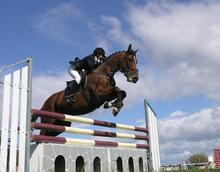With the up-coming Equestrian Olympic Games in London beginning in August 2012, owners and trainers of competing horses are preparing to make sure their horses are in tip-top shape for the eventing, jumping,and dressage contests.

Injuries necessitate quick diagnosis
The demand for thermal imaging cameras and related equipment has increased exponentially as Olympic equestrians protect the health of their horses.
As a major part of their proactive concern for the health of their equine athletes, the demand for thermal imaging cameras and related equipment has increased exponentially.
Although equine thermal imaging has been around for over 40 years. It has recently become all important to horse owners as a safe, effective economical diagnostic tool especially when equines need to be at the "top of their game."
In fact, during the 1996 Olympic Games in Atlanta, thermography was the most requested and used diagnostic tool. Because it is fast, portable, and non-invasive in detecting injury or problem sites, owners and trainers overwhelmingly chose use of thermography as a precourser to other diagnostic techniques once the area in question was identified.
The ability to detect the areas in muscles, tendons and ligaments where problems are beginning allows horse owners and trainers to prevent further injury that could lead to lameness or other catastrophic events.
Today, thermal imaging is receiving recognition as a safe, effective, economical, and valuable diagnostic tool. A specialized camera converts emitted energy (infared waves) into a picture visible by the human eye.
Emitted heat may be directly correlated to circulation, which in turn indicates inflammation. While people typically think of infrared as "the hot tool", thermal imaging is equally effective at locating "cold spots." Decreased temperature may indicate nerve damage, circulatory disruption, muscle atrophy, off-loading, and more.
It is important to remember that thermal imaging detects changes in metabolic function, but cannot tell specifically what the underlying problem is. Anatomic imaging such as radiographs or ultrasound are often needed to determine the specific lesion, while thermal imaging is an excellent locator of problems and can help gauge the healing processes over time.
Thermal imaging is vital in whole horse diagnostics with the ability to determine areas of pain, tendon and ligament injuries before clinical signs are detectable, bone problems, abscesses, circulatory disturbances and other early indicators of physical problems
